Menu
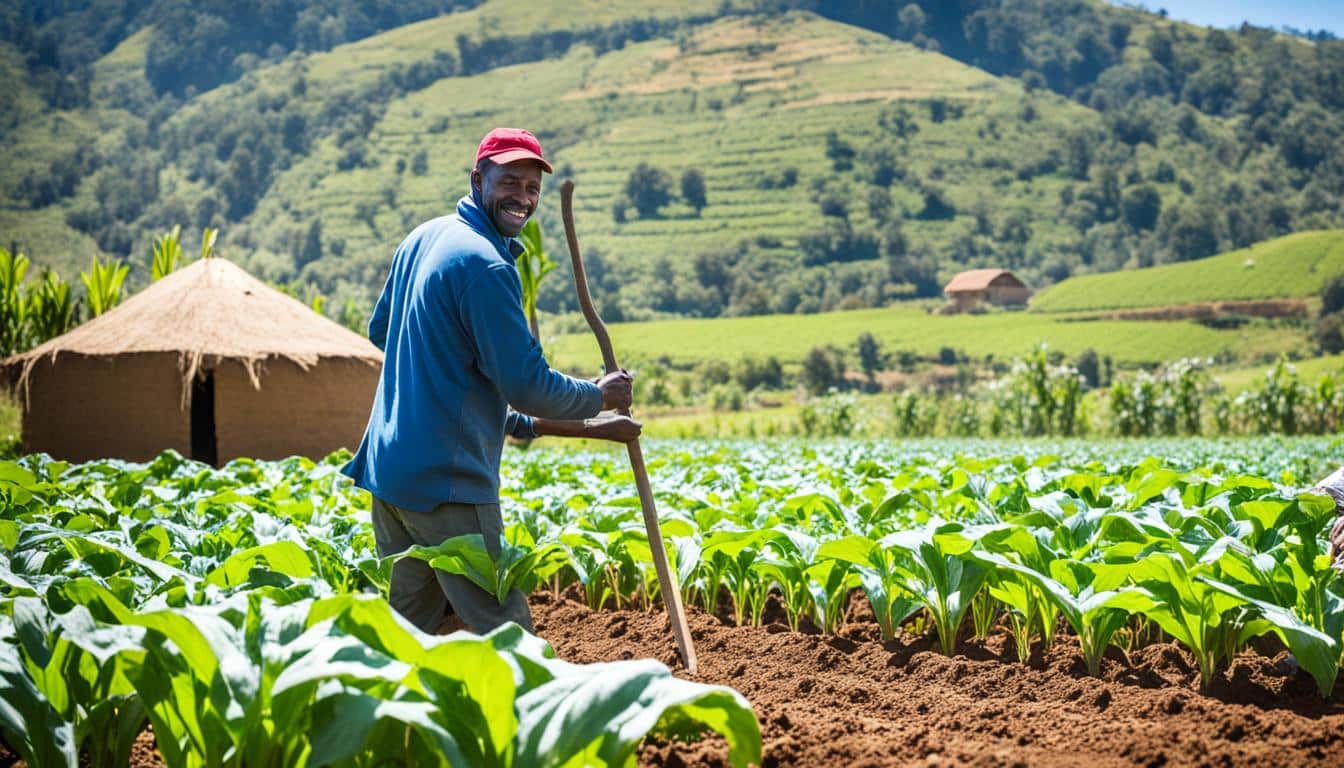
Did you know Priscilla Mwihaki, a small farmer, saw her corn harvest drop drastically? She went from harvesting 90 kilograms per acre to only 10 kilograms. This decline is a big issue for many small farmers in Kenya, who provide most of the country’s food.
Due to these falling crop yields, farmers are looking into new methods to keep their farms going. Priscilla, for example, is now growing crops that bugs don’t destroy, like cassava and sweet potatoes. She’s also trying out new ways to save and use water, even though it’s hard to find money for these changes. But it’s all part of an important shift towards making more food in a way that doesn’t use up so many resources.
Hope Valley Family Institute (HVFI) plays a key role in this change. They help 750 farmers in Kenya by teaching them smart farming techniques and showing them in the field. Their work supports the local people, helps fight climate change, and makes sure there’s enough to eat.
Smallholder farmers are key to Kenya’s food and economic well-being. They make up over 70% of the agriculture sector. Their work feeds the nation and drives local and national economies forward. These farmers contribute to rural growth and fight against poverty.
Kenya depends on smallholder farmers for its food. Over 33 million people are part of this vital sector. They grow must-have crops ensuring food is always available.
Projects like FarmWorks’ help over 2,000 farmers. The banana project aids 2,000 farmers in Taveta. Such efforts make sure food supply chains are strong.
These farmers also protect the land. Their methods reduce the impact of bad weather. This keeps farming sustainable and helps fight hunger.
The impact of smallholder farmers goes beyond food. In places like Sub-Saharan Africa, agriculture makes up over 20% of the economy. Their work not just helps them but also the country.
Special schemes, like the Horticultural Code, improve farming standards. This means better products that can reach bigger markets. Training these farmers in eco-friendly methods is crucial. It boosts food production and helps in climate change.
| Programme | Target Farmers | Description |
|---|---|---|
| Banana Project in Taveta | 2,000 | Promotes banana farming among local farmers to improve livelihoods and food security |
| FarmWorks Out-grower Programme | 2,000+ | Supports smallholder farmers with agronomic practices to enhance crop yields |
| KS 1758-Horticultural Code of Practice | Nationwide | Enhances farm assurance systems and compliance with agricultural laws |
For Kenyan small-scale farmers, adopting sustainable methods is vital. This includes using water well and growing crops that bugs don’t like. Doing this helps to fight the unpredictable weather and boost crop yields.
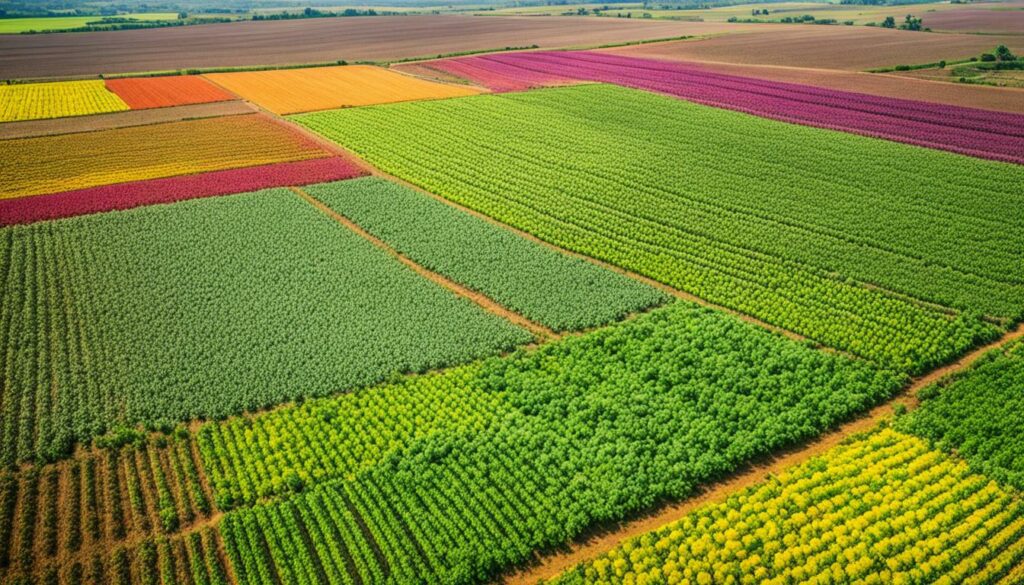
When it comes to farming, managing water wisely is key. The Krishi Jyoti project is a great example. It has taught farmers to use water for irrigation more efficiently on 1,493 acres, saving a massive 291 million litres of water every year.
This project also built seventeen check dams. Together, they can hold up to 66.82 million litres of water a year. All this has helped to refill the groundwater, with a total annual water recharge of 133.66 million litres. For small farmers, tools like shade nets and water pumps, along with making water pans, are essential. They help use water better, which supports long-lasting farming practices.
Growing crops that bugs don’t damage is a must for small farmers. By showing how to do this with crops like cotton, wheat, and tomato, the Krishi Jyoti project has helped a lot. It’s seen in the 37,080 demonstrations it has run. These efforts have increased crop yields and the variety of veggies available. This means more food types for families and extra money from selling surplus harvests for 431 women farmers.
By using these techniques, small farmers in Kenya can fight off the effects of changing weather, increase what they grow, and keep their incomes safe.
Climate-smart agriculture is improving the lives of Kenyan farmers. It tackles the challenges of unpredictable weather and shifting seasons. This is especially important for small farms in Kenya, where almost all farming depends on rain. This means they are at risk when the climate changes.
Agriculture makes a big part of Kenya’s economy, with farming being essential for many. In Laikipia and Nyeri, using climate-smart methods has greatly increased bean harvests. For example, production rose from 1.5 bags per acre to 5. These new ways of farming help keep up the harvests, even when the weather is less friendly.
A recent report shows that 80% of bean farmers have adopted better farming and pest control. This shows that more and more farmers are using smart techniques to farm.
Miriam Karwitha is leading the change by helping 4,000 farmers. She’s getting them to work together in groups and a cooperative. This team effort helps them buy farm supplies together, market their crops as a group, and saves money. It makes them stronger together.
Working together and sharing what they learn is key to success in climate-smart farming. For Kenyan small farms, using these methods is essential. It helps them stay strong and do their part in the country’s economy.
In summary, using climate-smart farming techniques is crucial for Kenya. It helps farmers face the challenges of the weather, keeps up with farming well, and makes sure farming stays important for Kenya’s future.
Small farms in Kenya are key for the economy and keeping people fed. But many problems hurt them, like the changing climate and trouble selling their goods or getting money.
The weather changing a lot hurts Kenyan farmers. They deal with less rain and more dry times, making it hard to grow crops or keep livestock healthy. Experts say it will get warmer in Kenya, which adds to the farmers’ challenges.

Farmers need help to be ready for these tough conditions. They should use smarter ways to farm that can fight climate change. Planting crops that can survive droughts and using water wisely are ways to help them.
Getting into big markets and getting money are big issues for Kenyan farmers. Most people who live outside cities work in farming, which is a big part of what Kenya sells to other countries. But they find it hard to reach bigger markets and loans are often too expensive.
| Key Statistics | Percentage |
|---|---|
| Agriculture’s contribution to GDP (direct) | 26% |
| Agriculture’s contribution to GDP (indirect) | 27% |
| Employment by agriculture sector | 40%+ |
| Rural population working in agriculture | 70%+ |
| Smallholder food production | 75%+ |
To help with these challenges, better ways to sell and money help a lot. Fair rules and using technology can bring farmers closer to bigger markets. This can make food and the country’s economy stronger.
In Kenya’s changing agricultural scene, organisations are key in helping farmers be more productive and resilient. The Hope Valley Family Institute (HVFI) and the CABI-led PlantwisePlus Programme are making a big difference.
HVFI is helping small farmers by teaching them about smart agriculture. They’re training farmers to use water wisely and grow crops that bugs don’t like. This helps farmers cope with the changing weather and keeps their farms going strong. Their work is also helping young people and women in the countryside, making villages better places to live.
The PlantwisePlus programme works on making sure that Kenya gets safe, high-quality food from local farms. They’ve made 52 guides about how to handle pests, like nematodes and moles, in Kiswahili. This makes it easier for local farmers to use these guides. The program also teams up with important Kenyan groups to make sure the food is safe, helping Kenya get more food security.
Below is an overview of some key initiatives:
| Initiative | Target | Focus Areas |
|---|---|---|
| HVFI | Various counties in Kenya | Climate-smart agriculture, pest management, youth and women empowerment |
| PlantwisePlus Programme | Kenya | Pest management, crop production, food safety |
In Kenyan agriculture, diversifying crops is key for resilience and sustainability. Priscilla Mwihaki from Mairo Inya shows us how it can help. It allows farmers to cope with unpredictable weather and market changes more effectively.
Diversifying crops helps small farmers in Kenya in many ways. It lessens the impact of climate change and keeps their income stable. Mixing different plants makes the soil healthier and enemies of plants, like pests, drop, boosting farm productivity.
Different planting methods, such as agroforestry and crop rotation, also help build better ecosystems. This makes farms more resilient to extreme weather.
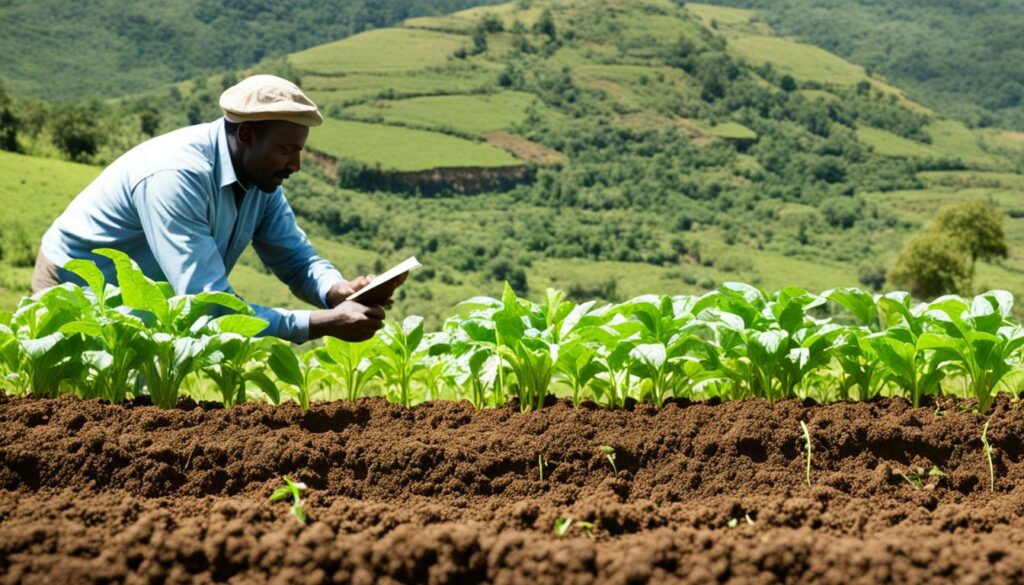
Many small farmers in Kenya are broadening what they plant. They’re growing crops that bugs don’t easily harm, like cassava and sweet potatoes. This choice shows a clear move toward overcoming common farming issues.
Hope Valley Family Institute (HVFI) is one group pushing for more tree planting and diverse fruits. They help farmers cultivate land in ways that both support the environment and add to their income.
A study in Land Use Policy, Volume 42 (2015) underlines the importance of diversifying crops. It looked at 315 homes in community projects that use irrigation. They found that an array of things, like how much money a family has and their access to farming advice, affect the variety of crops they grow.
This kind of strategy is crucial as the Earth changes. For more than 60% of African workers, mainly in rural areas, it’s a way to keep their livelihoods safe.
Diving into different crops on places like Mount Kenya’s slopes is very helpful. It prepares farmers to survive the possible 50% drop in crop yield by 2020. This kind of planning is their best bet for a secure food source and financial future.
Farmer empowerment in Kenya is key to the success of smallholder farmers. They are given training and mentoring in agriculture. This equips them with skills for sustainable farming and solving market challenges.
These programmes have made a big difference. In 2017, 38% of Kenyans worked in agriculture. This shows the importance of helping farmers. Groups like Hope Valley Family Institute (HVFI) and Centre for Agriculture and Biosciences International (CABI) are very helpful. They offer training that helps farmers succeed, even in tough situations.
In Iveti, the organisation Vunatec held training sessions that improved farmers’ abilities. The sessions were well-attended. People learned a lot from experts like Daniel. This shows how mentorship can really help farmers.
Many organisations work together to support farmers in Kenya. The QYourVenture programme and the Jim Leech Mastercard Foundation Fellowship provide funds and support for new farming ideas. These supports improve the way farming is done.
Here is a summary of the recent initiatives:
| Initiative | Details |
|---|---|
| Vunatec Training Sessions in Iveti | Many sessions improved farming skills |
| Daniel’s Workshop Participation | Lots of farmers attended the workshops |
| Jim Leech Mastercard Fellowship | Provided resources and support in Nairobi |
| QYourVenture Microgrants | Supported agricultural entrepreneurship |
It’s crucial to check if programmes like the SH EP PLUS are working. About 9,000 families are part of a three-year check to see if it helps. They look at how it changes their consumption, income, and more.
Farmer support, education, and mentorship will lead to a better future for Kenya’s farmers. These are the keys to lasting success in agriculture.
For Kenyan small farmers, embracing Good Agricultural Practices (GAPs) is key. It boosts food safety and meets tough safety rules both at home and abroad. By using GAPs, farmers make their food better and outshine others in the market.

Sticking to safety rules is at the heart of GAPs. The Kenya Standard 1758-Horticultural Code of Practice is a must-follow. It ensures high safety levels, letting small farmers shine in the market, everywhere. By obeying these rules, farmers cut the risk of bad food and make sure what they sell is safe.
Going for Good Agricultural Practices brings lots of perks for small farmers. The top one is better food that’s right for top markets. Good food means they can sell more and earn more. Plus, doing GAPs makes food safer, hitting the safety standards well.
Also, getting trained and help, like visits and messages, really boosts how well farmers do with GAPs. In Kenya, 84% of farmers said they learned a lot from these, choosing to farm more sustainably. This helps them make more food, sell better, and keep their businesses going strong.
Climate change is affecting our world’s farms. This is especially true in Kenya. Here, innovative ways to collect water are key for farming to stay sustainable. Small farmers are at the forefront of this challenge. They grow much of the world’s food. Yet, they get little help to tackle climate change. They must find ways to adapt to changing weather patterns to keep their farms running.
Building water pans is a smart move to deal with water shortages. These are small water reservoirs that capture rainwater. They provide a dependable source of water for crops when there’s not enough rain. The SPIS4FNS project in the Upper Ewaso Ng’iro Basin in Kenya is showing how effective this is. It’s a way to use less rain and save the little groundwater available. Water pans are great for making sure there’s enough food and that farming can cope with climate changes.
Shade nets and water pumps are also making a big difference. Shade nets control the temperature and keep moisture near the crops. This saves water that would otherwise evaporate. Water pumps then move the collected water to the fields. This helps crops grow even when there’s not much rain. Hope Valley Family Institute (HVFI) and others are teaching these methods. They help farmers protect their crops, even as climate change makes life harder.
The need for new water harvesting methods is clear. For farmers in Kenya, these include building water pans, using shade nets, and water pumps. Together, they make sure there’s always water for farming. This boosts how much food can be grown and helps farmers face the challenges of climate change.
The COVID-19 impact on Kenyan farming was huge for small-scale farmers. Many faced new challenges they had never seen before. Recent data shows that in places with strict rules, 80% of households had to cut down on food.
Interviews with 30 farmers in Kenya showed how big these problems were. The pandemic didn’t just hurt food. It also dropped the money families made from activities not related to farming.
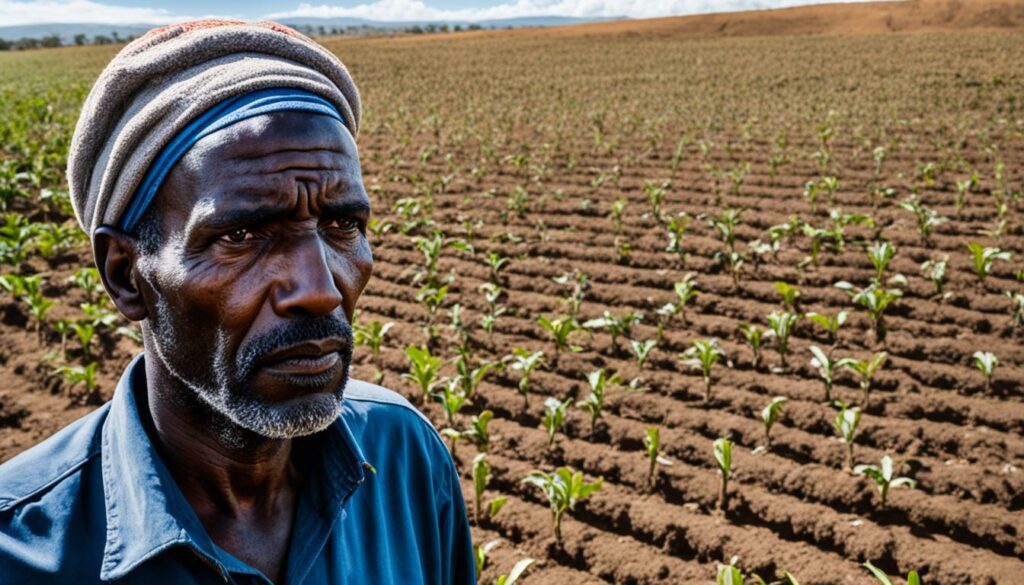
Almost all families saw a 50% drop in income. Sales from farming also went down a lot. This was because what they sold was either not needed or didn’t fetch good prices.
In areas with less strict rules, 20% of families still suffered. Many used different ways to survive, with some 30% to 90% trying different methods to fight off bad effects on their food and livelihood.
“By the end of 2020, the World Bank estimated that an additional 88 to 115 million people were pushed into extreme poverty due to the pandemic.”
Efforts have been made to help these farmers. For example, a stimulus package of KES 1.5 billion (~USD 15 million) focused on those growing crops and flowers. But, only 200,000 farmers were helped this way, showing the need for more.
The survey also showed that only a few farmers got money support. They mostly got help with loans. Farmers’ main worries were lower harvests, higher prices for supplies, and more money spent on getting things from here to there.
| Location | Food Consumption Impact | Off-Farm Income Reduction | Loss in Farm Sales Revenue | Adoption of Coping Strategies |
|---|---|---|---|---|
| Stringent Measures Areas | Up to 80% | Almost all households | 50-75% | 30-90% |
| Relaxed Measures Areas | Around 20% | Not specified | Around 20% | Not specified |
Farmers are now told to broaden their fields, improve after-harvest steps, and use technology better to reduce risks and become stronger. They really need more financial help and new ways to sell their produce. Also, simpler ways to get quick money, especially for women-headed households, could be key.
In Kenya, agribusiness opportunities are key for rural areas to grow. They help create connections to markets and include everyone. Especially, small farmers benefit since they make up the majority of those working in agriculture.
The development of market linkages in Kenya is vital for agribusiness growth. This is seen in policies that have been put in place for 18 crops, including maize, coffee, cotton, and sugarcane. These policies have made it easier for private companies to work with farmers. However, there have been some challenges.
After these changes, the profit for agribusinesses increased. But, farmers saw a decrease in their incomes. They lost around 6,600 Kenyan shillings (about USD 66). This shows there is still work to be done to balance things out.
Agribusiness opportunities also help get more young people and women involved in farming. For example, there’s the banana project in Taveta and the out-grower programme by FarmWorks Ltd. These initiatives connect small farmers to bigger networks, improving their earnings and edge in the market.
Almost three-quarters of Kenya’s farmers are small-scale. Projects like these are significant in boosting their economic power and the country’s economy. They have helped make agriculture contribute more to Kenya’s GDP, which is 24%.
Giving young and female farmers more opportunities is good for farming incomes and the future of agriculture in Kenya. With continuous support, these projects are for rural development. They are changing how markets work and who gets involved for the better.
| Category | Impact on Farmers | Impact on Agribusinesses |
|---|---|---|
| Income Change Post-Policy | -6,600 Kenyan Shillings | +5% to 9% Profit Margins |
| Market Engagement | Increased Participation | Smooth Operations |
| Labour Force Composition | 75% Rural Workforce | – |
Bringing indigenous plants and livestock into small farms has many benefits. It helps farming be more sustainable and makes communities stronger. Local plants and animals work well with the environment. This makes farming more efficient and better for the land.
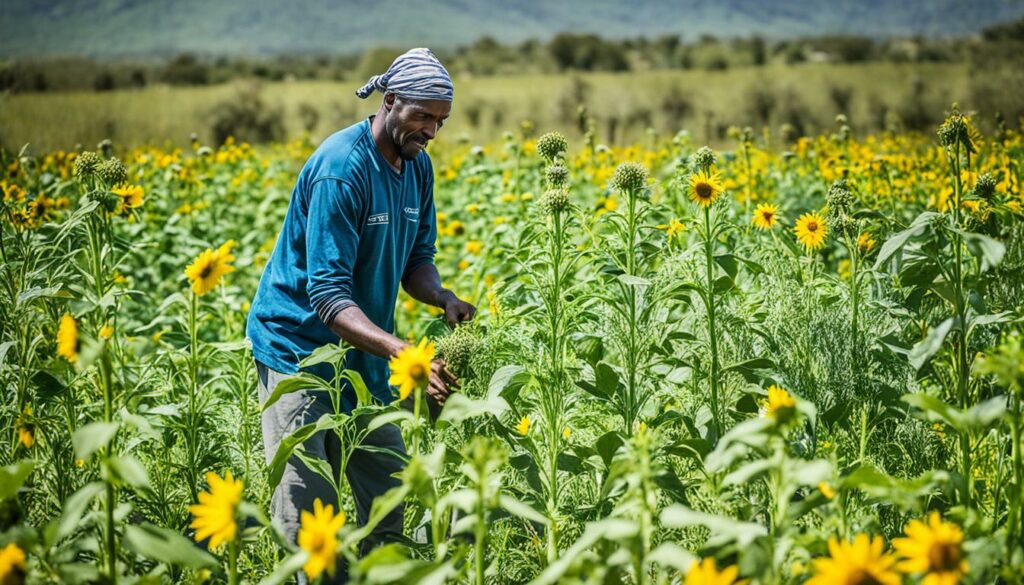
Local plants don’t need as much water or care as others. This saves money and is good for the environment. Indigenous animals also fight off illnesses better. This helps farmers spend less on vets and keeps their animals healthier.
In Kenya, local chickens do better against diseases than foreign ones. A study in 2012 found that they are stronger and more adaptable. This is good news for farmers. It means they can produce more and their farms are more likely to survive tough times.
Many places have shown that using local plants and animals is a great idea. The Hope Valley Family Institute teaches farmers about these helpful species. This way, everyone learns how to take care of them.
The East African Zebu cow is a good example. Farmers in the region have started to use them more. They are strong and give more milk. This has helped the local economy. A report from 2019 says it makes farming stronger and reduces the need for outside help.
A report by the World Economic Forum in 2019 said that more countries should start using local animals. It’s a smart move for the future. Kenya’s Ministry of Agriculture agrees. They say it helps their country grow in a good way.
Example of Integration Benefits:
| Indigenous Plant | Nutritional Value | Adaptability |
|---|---|---|
| Baobab | 10 times antioxidants of oranges | High resilience to drought |
| Sorghum | Rich in protein, iron, and fibre | Tolerant to heat and poor soil conditions |
The baobab tree is a great example. It’s really good for you. It has more than ten times the antioxidants of oranges. Plus, it has twice the calcium of spinach. Using local plants and animals is recommended in Africa. It helps the livestock business grow in a fair way.
Tree planting helps fight climate change and improves Kenya’s environment. The KENAFF Farm Forestry and Afforestation Initiative aims to raise the forest cover to 10% by 2022. They plan to achieve this by planting 2 billion trees.
This effort lowers the impact of climate change and makes farms more resilient. It also boosts food security. Farmers benefit by growing tree foods alongside their staple crops.
Planting trees goes beyond food; it supports more varied wildlife and helps combat climate change. In 2021, 120,000 trees were planted, thanks to smallholder farmers in Busia, Bungoma, and Kilifi. The Government aims to hit 30% tree cover by 2022.
The KENAFF National Tree Planting Weeks happen twice a year. They teach small farmers all over Kenya the value of tree planting. These events also suggest new ways to make a living, like raising small animals and making biofuels. These suggestions help cut down on carbon emissions.
| Tree Planting Initiative | Impact |
|---|---|
| KENAFF Farm Forestry and Afforestation Initiative | Improving resilience of agricultural systems, enhancing food and nutritional security |
| PlantVillage Team | Establishing nurseries, targeting 600,000 trees for 2022, training farmers |
| Government’s Tree Cover Target | Increasing target from 10% to 30% by 2022, aiming to plant 15 billion trees by 2032 |
By making tree farming a business, it brings more money to rural areas. The PlantVillage team plans to set up nurseries and train farmers. This empowers small farmers. They join the effort to protect our environment, all while earning well from planting trees.
Keeping food safe matters a lot in Kenyan small farms. CABI’s PlantwisePlus joins forces with the Micro-Enterprises Support Programme Trust, and FarmWorks Ltd. They help in making farm work sustainable. A big part of this teamwork is making guides to manage pests. These help farmers deal with many pest issues.

At a write shop, 52 Guides were created or improved. They cover a variety of crops. They were made by experts to help with pests like nematodes and mole
These guides not only solve the problems but also teach farmers better ways. This leads to safer food for everyone.
Aiming for Good Agricultural Practices (GAPs) is key. CABI and others work hard to get farmers to follow these rules. This is especially true for MESPT’s banana project.
Being strict with GAPs means meeting high safety standards. It also makes farm goods better and safer.
FarmWorks’ out-grower programme involves over 2,000 farmers. Following both the Pest Guides and GAPs can really up the quality of their produce. This keeps diseases away and gets them into better markets, earning more.
| Pest Challenges | Management Solutions Developed |
|---|---|
| Nematodes | Crop rotation, resistant varieties |
| Moles | Trapping, natural predators |
| Thrips | Sticky traps, neem oil |
| Banana Weevils | Sanitary measures, biological control |
| Cigar End Rot | Proper ventilation, fungicides |
| Panama Disease | Resistant cultivars, soil management |
| Sweet Potato Weevil | Crop rotation, pheromone traps |
In vulnerable farming communities, strategies are key to resilience. Diversifying the economy helps a lot. Organisations like AGRA and USAID are leading the way in Kenya. They’re helping small farmers through programmes such as the E-Voucher. Over the past three planting seasons, over a million farmers got help. 130,000 farmers received subsidies.
Improving economic strength involves diversifying activities. This approach has helped 65,809 farmers in Kenya. They sold crops worth $60,865,719. And it didn’t stop there. Help also went to 26 youth enterprises and 1,186 small and medium businesses. They received access to $39,084,537 in credit. This boost created 232 new jobs, adding a layer of protection against financial hardship.
Producing more seeds was also part of the plan. It led to 8,069 MT of better seeds. This means more yield and economic stability for small farmers.
Improvements in health and cleanliness are crucial for resilience. Getting clean water and better sanitation is a big deal, especially in places like Isiolo County. Efforts from ACDI/VOCA and USAID Kenya are making a real difference. They’re tackling water shortages. This is helping communities get ready for tough times.
[]This work improves health and supports resilience overall. Clean water is vital for farming and community health.
Smallholder farming in Kenya is key for the country’s food supply. It contributes over 70% to the nation’s agricultural output. This boosts rural growth and community wealth.
In Kenya, smallholder farmers are essential for food security. They grow most of the food eaten locally. This reduces the need for importing food and depending on aid.
Smallholder farmers strengthen the economy of rural areas in Kenya. They produce goods, create jobs, and boost local trade. This supports many people’s lives and the entire nation’s economy.
Efficient water use is vital for Kenyan farmers. They can build water pans and employ tools like shade nets and water pumps. Growing crops like cassava and sweet potatoes, which resist pests, is also advised.
Climate-smart agriculture helps Kenyan farmers face unpredictable weather and climate change. By using strong farming methods, they safeguard their crops and continue making a living.
Kenyan farmers deal with changing weather and hard times accessing markets and money. These issues reduce their productiveness and ability to sustain their farms.
HVFI helps farmers by teaching climate-friendly farming and introducing new methods. They aim to boost how much farmers can grow and how long they can keep their farms going.
The PlantwisePlus programme by CABI supports lasting crop production and pest control. It offers key tools like Pest Management Decision Guides. These help farmers produce food that’s both high-quality and safe.
Different crops make farmers less vulnerable to climate change and unstable markets. Growing various types of crops means more reliable incomes. For instance, crops like cassava and sweet potatoes are good choices.
Teaching and mentoring farmers gives them the knowledge and skills for successful, sustainable farming. They learn to manage resources better and overcome marketplace challenges. This helps them produce more and be more independent.
Good Agricultural Practices ensure food is safe and of high quality. By following these practices, smallholder farmers can better their produce and meet safety standards. This opens doors to more markets.
Smallholder farmers can use creative methods for water like building water pans, shade nets, and water pumps. These techniques counter water scarcity and increase ability to face climate changes.
COVID-19 cut off routes to markets and made life harder for farmers in Kenya. It pushed organisations to help more with lasting food production. This focus shifted from just giving aid to ensuring farmers can stand on their own.
Agribusiness helps rural areas grow by connecting them to markets and supporting the youth and women in farming. It makes smallholder farmers part of bigger farming developments. This makes their work more successful and profitable.
Using local plants and animals can make farms more stable and reduce costs. These species are often better suited to local conditions than foreign ones. This leads to a more secure food future.
Planting trees lowers greenhouse gases in Kenya. Trees like avocados not only help the environment but also improve food security and offer income for farmers.
To keep food safe, smallholder farmers can use guidelines and tools from programmes like CABI’s PlantwisePlus. These help cut risks from pests and keep food healthy.
Communities can get stronger by doing different jobs, being healthier, and farming sustainably. Organisations like USAID are helping. They prepare communities to endure tough times, whether from the climate or the economy.